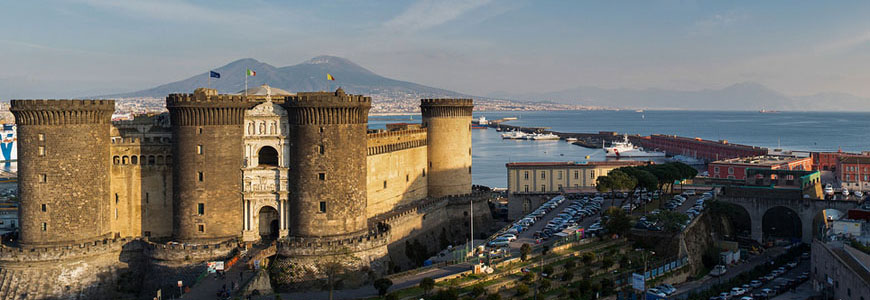Pompeii archaeological site
Campania, Italy
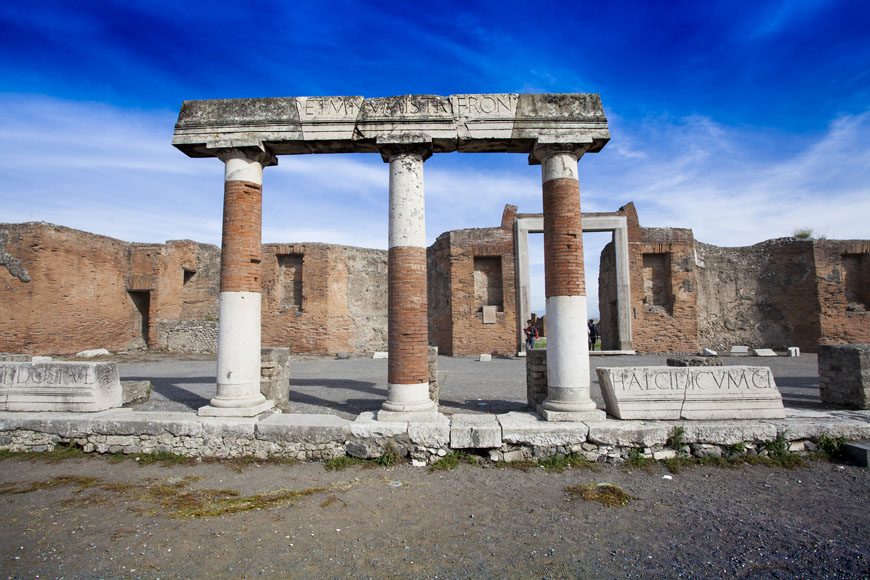
Pompeii is an archaeological site near Naples, southern Italy, featuring the ruins of an ancient Roman town destroyed in 79 AD by the eruption of Mount Vesuvius.
History of Pompeii
Founded in the 8th century BC, in the 1st century AD Pompeii was a wealthy port town and vacation resort, quite popular among affluent Roman citizens; the inhabitants of the town at the time of its destruction are estimated between 10,000 and 20,000.
In 79 AD, probably on August 24th (not all scholars agree on that day), a sudden eruption of Mount Vesuvius threw a gigantic cloud of volcanic gas, ash, and molten rock toward the sky, reaching an approximate height of 26 kilometers / 16 miles.
Thereafter, incandescent pyroclastic flows, toxic gas clouds, and rain of ash and pumice fell on Pompeii, killing thousands and burying the town under a dense layer of volcanic dust, 20 to 32 feet thick, yet leaving many buildings largely intact except for the roofs, most of which collapsed.
An aerial view of Mount Vesuvius (looking north, photo by Ross Elliott (CC BY 2.0))
A description by Pliny the Younger vividly illustrates what happened during the eruption: “On 24 August, in the early afternoon, my mother drew (my uncle’s) attention to a cloud of unusual size and appearance. (…) It was not clear at that distance from which mountain the cloud was rising (it was afterward known to be Vesuvius); its general appearance can best be expressed as being like an umbrella pine, for it rose to a great height on a sort of trunk and then split off into branches (…). In places, it looked white, elsewhere blotched and dirty, according to the amount of soil and ashes it carried with it. (…) Ashes were already falling, hotter and thicker (…), followed by bits of pumice and blackened stones, charred and cracked by the flames. (…) Meanwhile, on Mount Vesuvius broad sheets of fire and leaping flames blazed at several points, their bright glare emphasized by the darkness of night. (…) the buildings were now shaking with violent shocks, and seemed to be swaying to and fro as if they were torn from their foundations. (…) Elsewhere there was daylight by this time, but they were still in darkness, blacker and denser than any ordinary night, which they relieved by lighting torches and various kinds of lamps. My uncle decided to go down to the shore and investigate on the spot the possibility of any escape by sea, but he found the waves still wild and dangerous. A sheet was spread on the ground for him to lie down, and he repeatedly asked for cold water to drink. Then the flames and smell of sulfur which gave warning of the approaching fire drove the others to take flight and roused him to stand up. He stood leaning on two slaves and then suddenly collapsed, I imagine because the dense, fumes choked his breathing by blocking his windpipe which was constitutionally weak and narrow and often inflamed. When daylight returned on the 26th – two days after the last day he had been seen – his body was found intact and uninjured, still fully clothed and looking more like sleep than death.” (From the First Letter of Pliny the Younger to Cornelius Tacitus)
The rediscovery
After the disaster, with the old town covered by a shroud of volcanic dust, Pompeii was forgotten for centuries.
It was only in 1748, following the fortuitous discovery of the ruins of Herculaneum ten years later, that a series of excavations ordered by the King of Naples eventually led to the rediscovery of Pompeii.
Despite over two centuries having passed, the archaeological excavation still continues today, since it is estimated that only two-thirds of the ancient town has been uncovered so far, and only one-third is open to the public.
A view of Pompeii in 1838 (Hannah Palmer, Street of Tombs, Pompeii, 1838, graphite, watercolor and gouache, Chazen Museum of Art, University of Wisconsin-Madison) and today (photo by Heleen Kwant (CC BY-NC 2.0))
But what did the ancient Pompeii look like and what do we know about it?
The town occupied about 66 hectares / 163 acres and was encircled by 2-mile long city walls provided with seven gates; It was a mid-sized town located in a panoramic site overlooking the Mediterranean Sea, very close to the southern side of the Vesuvius; it is believed that the climate was colder in ancient times than it is today, and paleobotanical studies suggest that Pompeii was surrounded by fir tree forests, orchards, and cultivated fields.
The town was quite wealthy, due to its being both a mercantile center and a leisure destination, and it featured basalt stone-paved streets and magnificent buildings, including six bathing complexes, theaters, stadiums, swimming pools, temples, hotels, a large number of shops – there were 34 bakeries which produced many types of bread and even dog treats -, bars and restaurants, thermopolia (the Roman equivalent of modern fast foods), private villas, and imposing public buildings.
As in most Roman cities, the urban fabric was based on a rectangular grid, with the Forum and main public buildings roughly at its center, while theaters and sports arenas were built adjacent to the city walls.
Two views of Pompeii’s Forum, photos by Shamefullyso (CC BY 2.0), and lhourahane (CC BY 2.0).
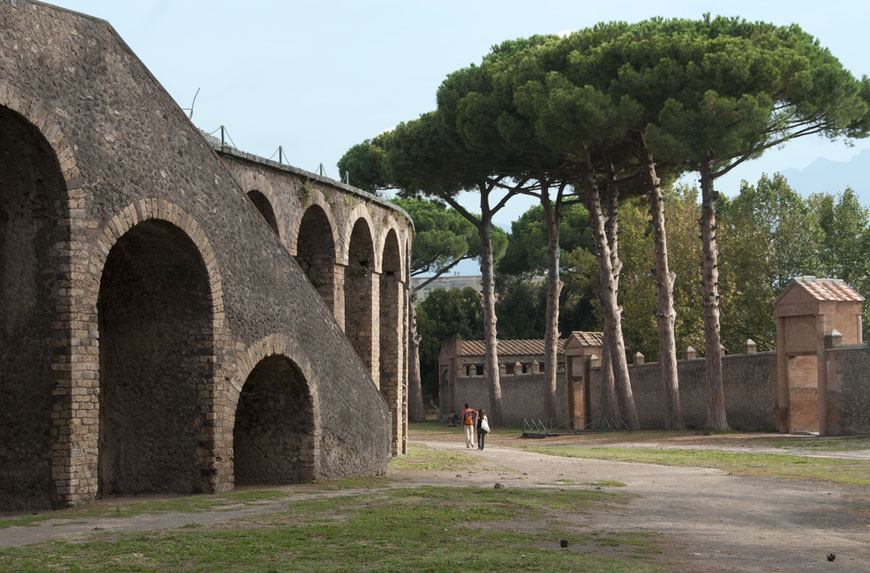
View of the archaeological site with the Large Theater on the left; photo by Heleen Kwant (CC BY-NC 2.0).
The archaeological site today
Pompeii is one of the world’s most visited archaeological sites, with about 3 million visitors in 2015. As mentioned earlier, 35 percent of the town, about 500 buildings, is currently open to the public.
Yet, what makes Pompeii exceptional is not its extension, but its unique character of being an ancient town “frozen in time”.
Many private buildings still retain part of their original decorations, such as those adorning the Villa of the Mysteries, the House of the Faun, the House of the Orchard, the House of Venus in the Shell, the House of the Vettii, the House of the Tragic Poet, and the Villa of Diomedes, among others.
The decorative apparatus of Pompeii’s buildings included the famous fresco paintings whose four styles, spanning more than two centuries of artistic evolution, substantially inspired the art of the 18th and 19th centuries, especially Neoclassicism.
House of Vettii, photo by Peter Stewart (CC BY-NC 2.0).
House of Venus in the Shell, photo by Heleen Kwant (CC BY-NC 2.0).

The “Casa degli Scienziati” house, photo by Pikakoko (CC BY-NC-ND 2.0).
Villa of the Mysteries, photo by Rachel Clarke (CC BY-NC 2.0).
Detail of a fresco painting in the Villa of the Mysteries by Shakko (CC BY-SA 4.0).
Also, some large public buildings are still in exceptional condition, including the Forum, the Basilica, the Small Theater, the Odeion, the Large Palaestra, and the Samnite Palaestra. The 20,000-seat Large Theater (Teatro Grande, also famous as the location of Pink Floyd’s Live At Pompeii documentary film) still regularly houses live performances and music concerts. Yet, the most surprising experience this archaeological site provides is the chance to aimlessly wander around the most ordinary streets of an entire ancient town, still flanked by what once were lively artisan workshops and retail stores.
The Large Theater of Pompeii, photo Gabriele Ravanetti (CC BY 2.0).

The Forum Baths, photo by Pikakoko (CC BY-NC-ND 2.0).
A street of Pompeii, photo scruff monkey (CC BY-NC 2.0).
Although many artifacts recovered on site are now on view at the Archaeological Museum of Naples and in the Museum of Boscoreale, in the Antiquarium, the small museum that is part of the archaeological site, the visitors can see the famous plaster casts of the inhabitants caught in the moment they were killed during the eruption, as well as mosaics, frescoes, sculptures, and architectural decorations.
The Pompeii site visitor services include a cloakroom, a restaurant bar, and a bookshop. Pompeii can be reached from Naples in about 50 minutes by car, bus, or train.
Plaster cast in the Antiquarium Museum of Pompeii, photo by Heleen Kwant (CC BY-NC 2.0).
Photo by skiena (CC BY-NC-ND 2.0).
Pompeii, map of the site, courtesy of Soprintendenza Pompei (click for larger image)
Cover image by Mike Knapp (CC BY 2.0).
How our readers rate this museum (you can vote)
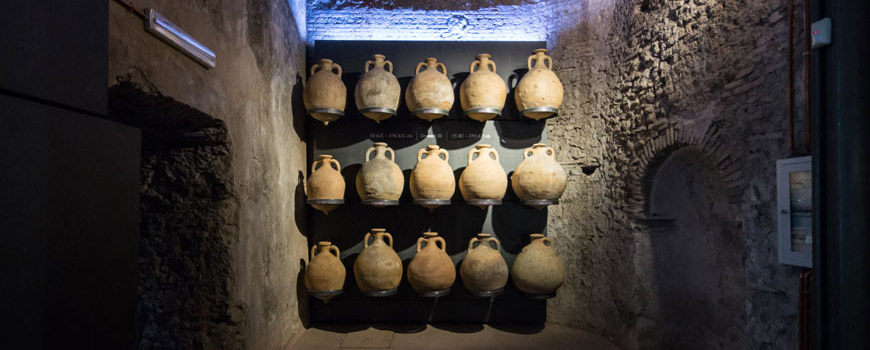
Museums of Archaeology and Archaeological Sites around the World
copyright Inexhibit 2024 - ISSN: 2283-5474

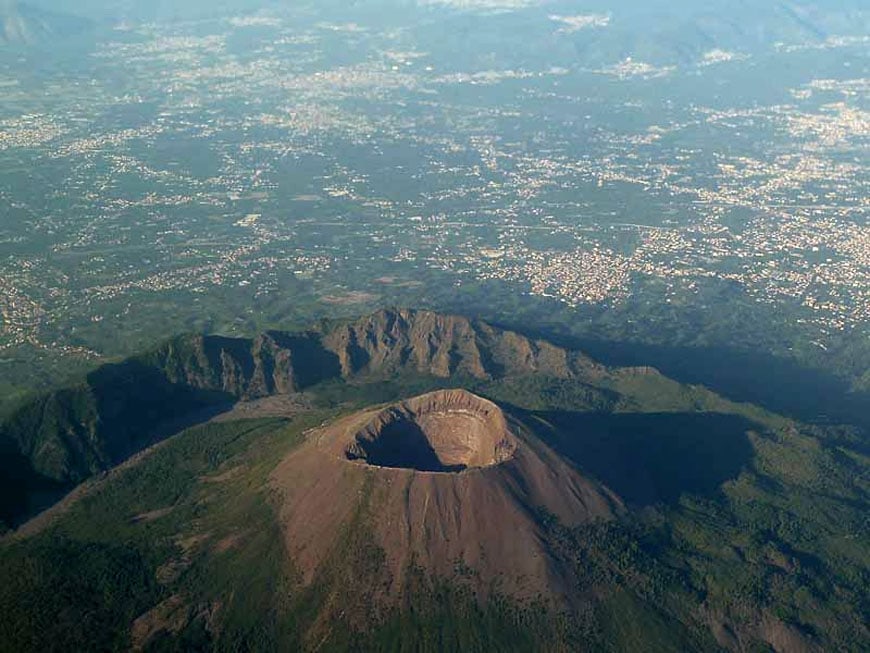




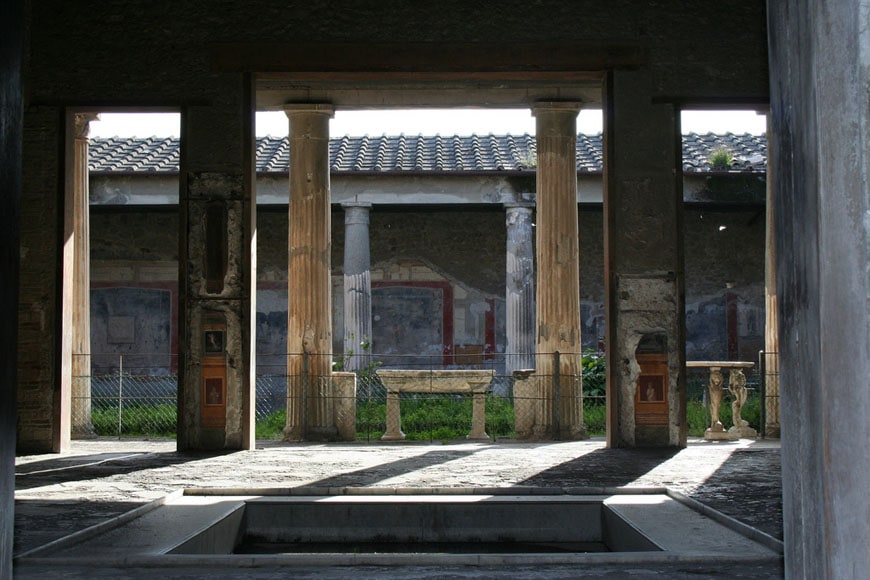

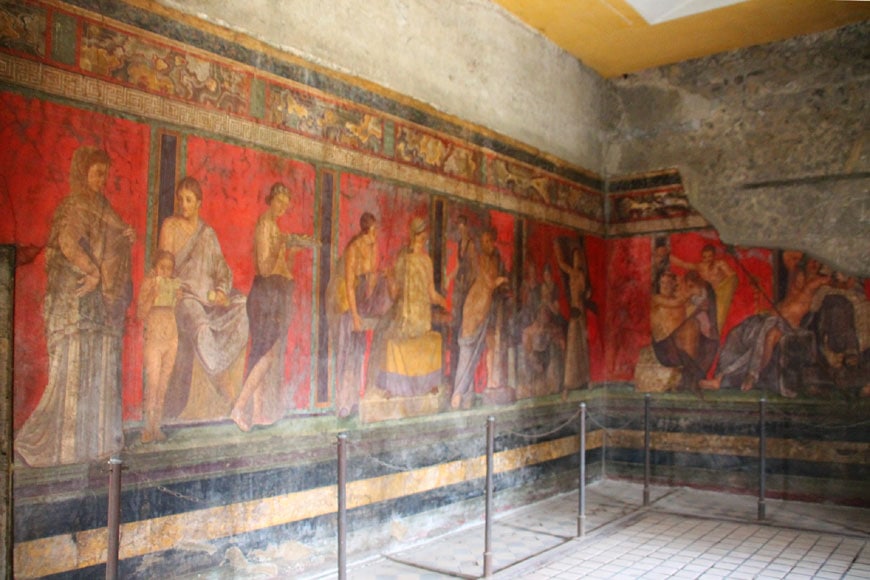


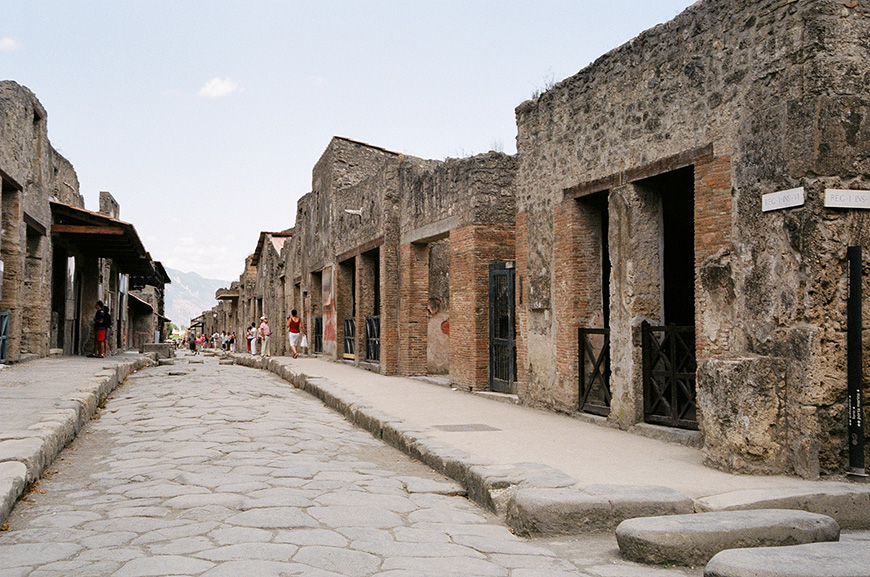


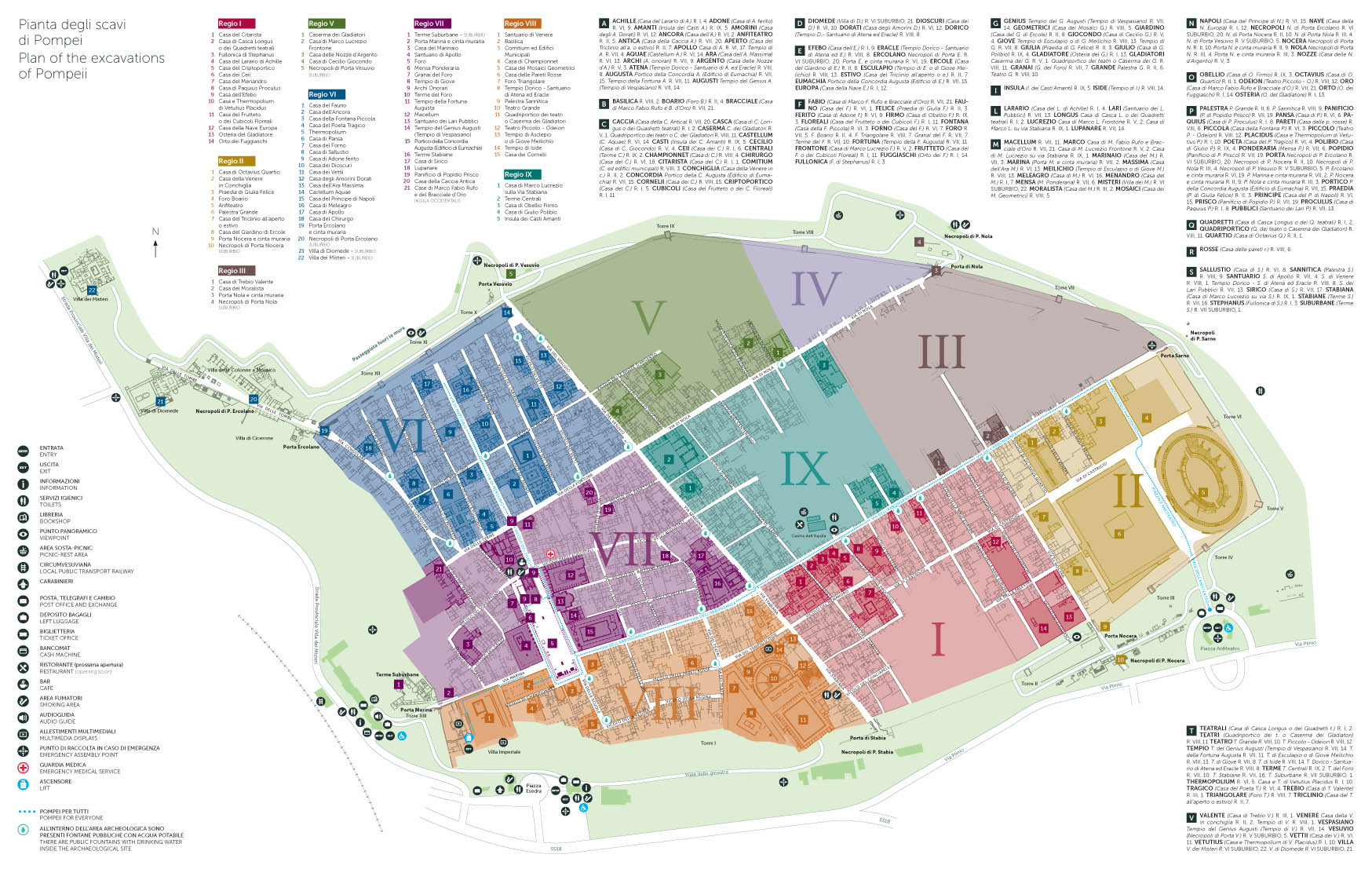

 (16 votes, average: 4.13 out of 5)
(16 votes, average: 4.13 out of 5)